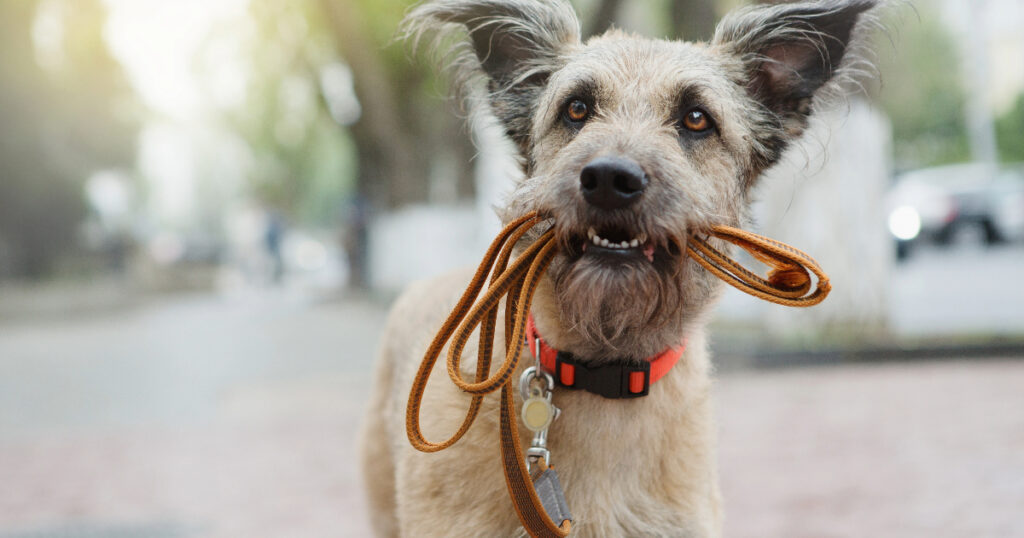Dogs and collars seem to go hand-in-hand. As responsible pet owners, we want to keep our canine companions safe and healthy. But do we really know all the reasons why it’s so important for dogs to wear collars?
There are actually many diverse benefits and legal requirements related to dogs sporting collars. Keep reading to learn about the surprising multitude of collar functions.
Collars Allow You to Attach Identification Tags

One of the main reasons your dog should wear a collar is so you can attach ID tags. ID tags display your contact information so your dog can be identified and returned to you if they ever get lost or separated from you.
By law in the UK, dog ID tags must include your name, address, and postcode. It’s also highly recommended to add your phone number. Some owners choose to leave their dog’s name off ID tags to avoid making it easier for thieves, but this is a personal choice. Having your dog’s name on the tag can help expedite the return of your lost dog.
Make sure to check your dog’s collar and ID tags regularly for wear and update the information if you move. Frayed collars and tags that have fallen off do your dog no good!
Collars Are Required by Law in Public Spaces
It’s not just recommended for your dog to wear a collar – it’s the law. The Control of Dogs Order 1992 states that any dog in a public place must wear a collar with owner identification attached. There are a few exceptions for working dogs, but failure to follow this law can result in unlimited fines or even jail time.
So don’t even think about taking your dog’s collar off when you’re out in public unless they fall under the working dog exemption. Even if your dog is microchipped, they still must wear a collar outside.
Collars Allow You to Attach a Leash for Walks

For many dogs, going on walks is one of the highlights of their day. But leashes must be attached to a collar in order for your dog to be safely restrained on walks. Even if you prefer using a harness for walks, your dog still needs a collar with ID to attach the leash to the harness.
While a harness can help protect your dog’s neck and trachea, the leash clip needs to connect to a collar for walks. Make sure your dog’s collar is properly fitted so the leash stays securely fastened during walks.
Collars Enable You to Quickly Control Your Dog
As much as we love our canine companions, sometimes they need to be quickly controlled or redirected. Whether your dog is fixated on squirrel chasing or bolting towards a busy road, you need to be able to promptly grab their collar to get them back on track.
Having a collar on enables you to swiftly take control of your dog in the event of an emergency. You can then redirect their attention and move them to safety. Don’t yank on your dog’s collar harshly, but having that grab point can help prevent dangerous situations.
Collars Allow for Proper Identification at the Vet
Bringing your dog to the vet usually involves interacting with receptionists, technicians, and the veterinarian. Having your dog wear their collar at the vet ensures they are properly identified by name throughout the visit.
The vet staff needs to be able to match your dog to their medical chart. Your dog’s name tag on their collar is visual confirmation that they are getting the right dog’s information. Don’t let your dog go naked to the vet!
Collars Offer Dogs Comfort Through Routine
Dogs thrive on routine and consistency. Once your dog gets used to wearing a collar daily, it becomes part of their identity and a source of comfort.
Taking your dog’s collar away suddenly could create stress, as it disrupts their sense of normalcy. Dogs like knowing what to expect each day – and for most dogs, wearing a collar is part of their predictable schedule.
Collars Can Indicate a Dog is Owned
Unfortunately, some ill-intentioned people steal dogs to use for fighting rings or breeding purposes. However, a dog wearing a collar indicates that they likely have an owner who cares for them.
Hopefully, the identification tags can help reunite a stolen dog with their family. But at minimum, the presence of a collar signals that the dog is not a stray and deter theft.
Collars Allow for Customization and Self-Expression
Collars come in a huge variety of colors, patterns, and materials. They allow dogs and owners to show off their unique personalities. Your dog’s collar can match their favorite color or represent their alma mater.
Some dogs even have multiple collars to coordinate with different outfits! Collars are fun accessories that let your dog show off their style. Don’t forget seasonal collar changes to get your pup in the holiday spirit.
Collars Provide a Place to Attach Important Medical Information
If your dog has any medical conditions, allergies, or injuries, you can purchase engraved plates or tags to alert others. For example, tags can indicate that your dog needs to be calmed slowly, has epilepsy, or cannot consume certain foods.
Medical tags attached to your dog’s collar can provide crucial care information if you aren’t present to explain your dog’s health history and needs. This could be life-saving in emergency situations.
Collars Offer Security and Reassurance for Anxious Dogs
The predictability and routine associated with wearing a collar help many dogs feel more secure. But for some especially anxious or reactive dogs, the comfort and security go even deeper.
The constant tactile stimulation of a snug collar can have a calming effect, similar to swaddling an infant or applying compression clothing. Just like weighted blankets offer comfort for humans, collars can reassure dogs.
Collars Protect Dogs’ Necks from Direct Leash Pressure
Walks are important for physical and mental dog health. But improperly pulling and lunging on the leash can damage dogs’ necks. Collars disperse the pressure around the neck instead of on one point.
The ring on a collar helps avoid concentrated force on the trachea. Using a no-pull harness in conjunction with a collar is ideal, but a collar alone is better than only a neck leash.
So in summary, there are myriad important reasons for dogs to wear collars. They allow identification, follow laws, enable control, reassure dogs, and protect necks. Make sure your dog’s collar fits properly and remains comfortable.
FAQ
Do small dogs need to wear collars?
Yes, even small dogs must wear collars in public per UK law. However, small dogs should always be walked on a harness instead of their collar, to protect their delicate tracheas. The leash can be attached to both the harness and a separate collar. Make sure your small dog’s collar is lightweight and fits correctly.
Is it safe for my dog to swim with a collar?
Swimming while wearing a collar poses some risks. Pool or lake water can get trapped under the collar and be uncomfortable. The tags and hardware can also get caught or snagged. For dogs that swim frequently, a breakaway collar designed for water use is a smart choice. Otherwise, remove your dog’s collar before swimming sessions for safety.
Can my dog wear a collar if they have skin allergies?
If your dog has skin allergies or irritation, wearing a collar may worsen their discomfort. Try a soft, flexible collar made of comfortable material like leather or neoprene. Ensure the collar remains clean and dry. Discuss options with your vet if your dog’s skin condition makes wearing a collar difficult. They may recommend certain times to remove the collar.
Is it safe for my dog to wear a collar while crated?
Do not leave a collar on your dog while they are in a crate. Even properly fitted collars can get caught on crate wires or as your dog moves around. This can lead to scary choking hazards or even strangulation while you aren’t present. For their safety, remove your dog’s collar before crating them during the day or at night.
Can my dog wear a collar if they have neck injuries?
If your dog has any injuries to their neck, including cuts, sprains, or muscle strains, avoid having them wear a collar until fully healed. The pressure and rubbing from a collar can exacerbate neck injuries and cause further trauma. Check with your vet on the appropriate collar rest time for your dog’s specific neck injury to let it properly mend before resuming use.
Conclusion
Collars serve a wide variety of crucial purposes for dogs.
They allow identification if a dog is lost, follow public safety laws, connect leashes for control, provide reassurance through routine, express personality, attach important medical alerts, protect necks, and so much more.
Always ensure your dog’s collar fits properly and remains comfortable. Your dog’s collar is an essential piece of safety equipment and accessory.

